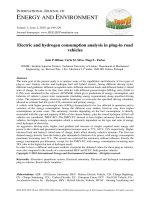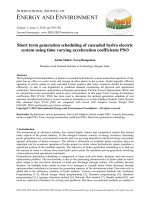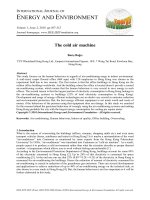electric machine ch02
Bạn đang xem bản rút gọn của tài liệu. Xem và tải ngay bản đầy đủ của tài liệu tại đây (1.07 MB, 24 trang )
Chapter 2 Transformers
This chapter is to discuss certain aspects of the theory of magnetically-coupled circuits, with
emphasis on transformer action.
The static transformer is not an energy conversion device, but an indispensable component in
many energy conversion systems.
It is a significant component in ac power systems:
Electric generation at the most economical generator voltage
Power transfer at the most economical transmission voltage
Power utilization at the most voltage for the particular utilization device
It is widely used in low-power, low-current electronic and control circuits:
Matching the impedances of a source and its load for maximum power transfer
Isolating one circuit from another
Isolating direct current while maintaining ac continuity between two circuits
The transformer is one of the simpler devices comprising two or more electric circuits coupled
by a common magnetic circuit.
Its analysis involves many of the principles essential to the study of electric machinery.
§2.1 Introduction to Transformers
Essentially, a transformer consists of two or more windings coupled by mutual magnetic flux.
One of these windings, the primary, is connected to an alternating-voltage.
An alternating flux will be produced whose magnitude will depend on the primary voltage,
the frequency of the applied voltage, and the number of turns.
The mutual flux will link the other winding, the secondary, and will induce a voltage in it
whose value will depend on the number of secondary turns as well as the magnitude of the
mutual flux and the frequency.
By properly proportioning the number of primary and secondary turns, almost any desired
voltage ratio, or ratio of transformation, can be obtained.
The essence of transformer action requires only the existence of time-varying mutual flux
linking two windings.
Iron-core transformer: coupling between the windings can be made much more effectively
using a core of iron or other ferromagnetic material.
The magnetic circuit usually consists of a stack of thin laminations.
Silicon steel has the desirable properties of low cost, low core loss, and high permeability
at high flux densities (1.0 to 1.5 T).
Silicon-steel laminations 0.014 in thick are generally used for transformers operating
at frequencies below a few hundred hertz.
Two common types of construction: core type and shell type (Fig. 2.1).
Figure 2.1 Schematic views of (a) core-type and (b) shell-type transformers.
1
Most of the flux is confined to the core and therefore links both windings.
Leakage flux links one winding without linking the other.
Leakage flux is a small fraction of the total flux.
Leakage flux is reduced by subdividing the windings into sections and by placing
them as close together as possible.
§2.2 No-Load Conditions
Figure 2.4 shows in schematic form a transformer with its secondary circuit open and an
alternating voltage
applied to its primary terminals.
1
v
Figure 2.4 Transformer with open secondary.
The primary and secondary windings are actually interleaved in practice.
A small steady-state current
(the exciting current) flows in the primary and establishes
an alternating flux in the magnetic current.
ϕ
i
= emf induced in the primary (counter emf)
1
e
1
λ
= flux linkage of the primary winding
ϕ
= flux in the core linking both windings
1
N = number of turns in the primary winding
The induced emf (counter emf) leads the flux by .
o
90
dt
d
N
dt
d
e
ϕ
λ
1
1
1
== (2.1)
111
eiRv
+
=
ϕ
(2.2)
if the no-load resistance drop is very small and the waveforms of voltage and flux
are very nearly sinusoidal.
11
ve ≈
t
ω
φ
ϕ
sin
max
=
(2.3)
t
dt
d
Ne
ωωφ
ϕ
cos
max11
== (2.4)
max1max11
2
2
2
φπφ
π
NfNfE == (2.5)
1
1
max
2 Nf
V
π
φ
= (2.6)
The core flux is determined by the applied voltage, its frequency, and the number of turns
2
in the winding. The core flux is fixed by the applied voltage, and the required exciting
current is determined by the magnetic properties of the core; the exciting current must
adjust itself so as to produce the mmf required to create the flux demanded by (2.6).
A curve of the exciting current as a function of time can be found graphically from the ac
hysteresis loop as shown in Fig. 1.11.
Figure 1.11 Excitation phenomena. (a) Voltage, flux, and exciting current;
(b) corresponding hysteresis loop.
If the exciting current is analyzed by Fourier-series methods, its is found to consist of a
fundamental component and a series of odd harmonics.
The fundamental component can, in turn, be resolved into two components, one in phase
with the counter emf and the other lagging the counter emf by
.
o
90
Core-loss component: the in-phase component supplies the power absorbed by
hysteresis and eddy-current losses in the core.
Magnetizing current: It comprises a fundamental component lagging the counter emf by
, together with all the harmonics, of which the principal is the third (typically 40%).
o
90
The peculiarities of the exciting-current waveform usually need not by taken into account,
because the exciting current itself is small, especially in large transformers. (typically
about 1 to 2 percent of full-load current)
Phasor diagram in Fig. 2.5.
1
ˆ
E = the rms value of the induced emf
Φ
ˆ
= the rms value of the flux
ϕ
I
ˆ
= the rms value of the equivalent sinusoidal exciting current
lags
by a phase angle
ϕ
I
ˆ
1
ˆ
E
c
θ
.
Figure 2.5 No-load phasor diagram.
3
The core loss equals the product of the in-phase components of the and
:
c
P
1
ˆ
E
ϕ
I
ˆ
cc
IEP
θ
ϕ
cos
1
=
(2.7)
= core-loss current, = magnetizing current
c
I
ˆ
m
I
ˆ
§2.3 Effect of Secondary Current; Ideal Transformer
Figure 2.6 Ideal transformer and load.
Ideal Transformer (Fig. 2.6)
Assumptions:
1. Winding resistances are negligible.
2. Leakage flux is assumed negligible.
3. There are no losses in the core.
4. Only a negligible mmf is required to establish the flux in the core.
The impressed voltage, the counter emf, the induced emf, and the terminal voltage:
dt
d
Nev
ϕ
111
== ,
dt
d
Nev
ϕ
222
== (2.8)(2.9)
2
1
2
1
N
N
v
v
=
(2.10)
An ideal transformer transforms voltages in the direct ratio of the turns in its windings.
Let a load be connected to the secondary.
0
2211
=
− iNiN ,
2211
iNiN
=
(2.11)(2.12)
1
2
2
1
N
N
i
i
=
(2.13)
An ideal transformer transforms currents in the inverse ratio of the turns in its
windings.
4
From (2.10) and (2.13),
2211
iviv
=
(2.14)
Instantaneous power input to the primary equals the instantaneous power output from
the secondary.
Impedance transformation properties: Fig. 2.7.
Figure 2.7 Three circuits which are identical at terminals
ab when the transformer is ideal.
2
2
1
1
ˆˆ
v
N
N
v =
and
1
1
2
2
ˆˆ
v
N
N
v =
(2.15)
2
2
1
1
ˆˆ
I
N
N
I =
and
1
1
2
2
ˆˆ
I
N
N
I =
(2.16)
2
2
2
2
1
1
1
ˆ
ˆ
ˆ
ˆ
I
V
N
N
I
V
⎟
⎟
⎠
⎞
⎜
⎜
⎝
⎛
= (2.17)
2
2
2
ˆ
ˆ
I
V
Z =
(2.18)
2
2
2
1
1
Z
N
N
Z
⎟
⎟
⎠
⎞
⎜
⎜
⎝
⎛
= (2.19)
Transferring an impedance from one side to the other is called “referring the impedance
to the other side.” Impedances transform as the square of the turns ratio.
Summary for the ideal transformer:
Voltages are transformed in the direct ratio of turns.
Currents are transformed in the inverse ratio of turns.
Impedances are transformed in the direct ratio squared.
Power and voltamperes are unchanged.
5
§2.4 Transformer Reactances and Equivalent Circuits
A more complete model must take into account the effects of winding resistances, leakage
fluxes, and finite exciting current due to the finite and nonlinear permeability of the core.
Note that the capacitances of the windings will be neglected.
Method of the equivalent circuit technique is adopted for analysis.
Development of the transformer equivalent circuit
Leakage flux: Fig. 2.9.
Figure 2.9 Schematic view of mutual and leakage fluxes in a transformer.
= primary leakage inductance, = primary leakage reactance
1
1
L
1
1
X
11
11
2 LfX
π
=
(2.20)
Effect of the primary winding resistance:
1
R
Effect of the exciting current:
()
2221
22111
ˆˆˆ
ˆˆˆ
INIIN
INININ
−
′
+=
−=
ϕ
ϕ
(2.21)
2
1
2
2
ˆˆ
I
N
N
I =
′
(2.22)
= magnetizing inductance, = magnetizing reactance
m
L
m
X
mm
LfX
π
2
=
(2.23)
6
Ideal transformer:
2
1
2
1
ˆ
ˆ
N
N
E
E
=
(2.24)
Secondary resistance, secondary leakage reactance
Equivalent-T circuit for a transformer:
22
1
2
2
1
1
ˆ
X
N
N
X
⎟
⎟
⎠
⎞
⎜
⎜
⎝
⎛
= ,
2
2
2
1
2
R
N
N
R
⎟
⎟
⎠
⎞
⎜
⎜
⎝
⎛
=
′
,
2
2
2
1
2
V
N
N
V
⎟
⎟
⎠
⎞
⎜
⎜
⎝
⎛
=
′
(2.25)-(2.27)
Steps in the development of the transformer equivalent circuit: Fig. 2.10.
The actual transformer can be seen to be equivalent to an ideal transformer plus external
impedances
Refer to the assumptions for an ideal transformer to understand the definitions and
meanings of these resistances and reactances.
Figure 2.10 Steps in the development of the transformer equivalent circuit.
7
Figure 2.11 Equivalent circuits for transformer of Example 2.3 referred to (a) the high-voltage side and (b) the low-voltage side.
§2.5 Engineering Aspects of Transformer Analysis
Approximate forms of the equivalent circuit:
Figure 2.12 Approximate transformer equivalent circuits.
8
Figure 2.13 Cantilever equivalent circuit for Example 2.4.
9
Figure 2.14 (a) Equivalent circuit and (b) phasor diagram for Example 2.5.
Two tests serve to determine the parameters of the equivalent circuits of Figs. 2.10 and 2.12.
Short-circuit test and open-circuit test
Short-Circuit Test
eqeq
jXR
+
The test is used to find the equivalent series impedance .
The high voltage side is usually taken as the primary to which voltage is applied.
The short circuit is applied to the secondary
Typically an applied voltage on the order of 10 to 15 % or less of the rated value will result
in rated current.
See Fig. 2.15. Note that .
mc
jXRZ //=
ϕ
Figure 2.15 Equivalent circuit with short-circuited secondary. (a) Complete equivalent circuit.
(b) Cantilever equivalent circuit with the exciting branch at the transformer secondary.
(
)
2
2
1
12
12
11
jXRZ
jXRZ
jXRZ
sc
++
+
++=
ϕ
ϕ
(2.28)
eqeqsc
jXRjXRjXRZ
+
=
+
+
+
≈
21
1211
(2.29)
Typically the instrumentation will measure the rms magnitude of the applied voltage ,
the short-circuit current
, and the power . The circuit parameters (referred to the
primary) can be found as (2.30)-(2.32).
sc
V
sc
I
sc
P
sc
sc
sceq
I
V
ZZ == ||||
(2.30)
10
2
sc
sc
sceq
I
P
RR ==
(2.31)
22
||
scscsceq
RZXX −== (2.32)
The equivalent impedance can be referred from one side to the other.
Approximate values of the individual primary and secondary resistances and leakage
reactances can be obtained by assuming that
eq
RRR 5.0
21
=
=
and
when all impedances are referred to the same side.
eqll
XXX 5.0
21
==
Note that it is possible to measure and directly by a dc resistance measurement
on each winding. However, no such simple test exists for
and .
1
R
2
R
1
l
X
2
l
X
Open-Circuit Test
The test is used to find the equivalent shunt impedance .
mc
jXR //
The test is performed with the secondary open-circuited and rated voltage impressed on the
primary. If the transformer is to be used at other than its rated voltage, the test should be
done at that voltage.
An exciting current of a few percent of full-load current is obtained.
See Fig. 2.16. Note that .
mc
jXRZ //=
ϕ
Figure 2.16 Equivalent circuit with open-circuited secondary. (a) Complete equivalent circuit.
(b) Cantilever equivalent circuit with the exciting branch at the transformer primary.
(
)
mc
mc
oc
jXR
jXR
jXRZjXRZ
+
++=++=
11
1111
ϕ
(2.33)
(
)
mc
mc
oc
jXR
jXR
ZZ
+
=≈
ϕ
(2.34)
Typically the instrumentation will measure the rms magnitude of the applied voltage ,
the open-circuit current
, and the power . The circuit parameters (referred to the
primary) can be found as (2.35)-(2.37).
oc
V
oc
I
oc
P
oc
oc
c
P
V
R
2
= (2.35)
oc
oc
P
V
Z =||
ϕ
(2.36)
()
()
22
/1||/1
1
c
m
RZ
X
−
=
ϕ
(2.37)
The open-circuit test can be used to obtain the core loss for efficiency computations and to
check the magnitude of the exciting current.
Note the term “Voltage Regulation” which is to be discussed in Example 2.6.
11
12
§2.6 Autotransformers; Multiwinding Transformers
Two-winding Other winding configurations. ⇒
§2.6.1 Autotransformers
Autotransformer connection: Fig. 2.17.
Figure 2.17 (a) Two-winding transformer. (b) Connection as an autotransformer.
The windings of the two-winding transformer are electrically isolated whereas those of the
autotransformer are connected directly together.
In the transformer connection, winding ab must be provided with extra insulation.
Autotransformer have lower leakage reactances, lower losses, and smaller exciting current
and cost less than two-winding transformers when the voltage ration does not differ too
greatly from 1:1.
The rated voltages of the transformer can be expressed in terms of those of the
two-winding transformer as
ratedrated
VV
L 1
=
(2.38)
ratedratedratedrated
LH
V
N
NN
VVV
⎟
⎟
⎠
⎞
⎜
⎜
⎝
⎛
+
=+=
1
21
21
(2.39)
The effective turns ratio of the autotransformer is thus
121
/)( NNN
+
.
The power rating of the autotransformer is equal to
221
/)( NNN
+
times that of the
two-winding transformer.
13
Figure 2.18 (a) Autotransformer connection for Example 2.7.
(b) Currents under rated load.
14
§2.6.2 Multiwinding Transformers
Transformers having three or more windings, known as multiwinding or multicircuit
transformers, are often used to interconnect three or more circuits which may have different
voltages.
Trsansformers having a primary and multiple secondaries are frequently found in
multiple-output dc power supplies.
Distribution transformers used to supply power for domestic purposes usually have two
120-V secondaries connected in series.
The three-phase transformer banks used to interconnect two transmission system of
different voltages often have a third, or tertiary, set of windings to provide voltage for
auxiliary power purposes in substation or to supply a local distribution system.
Static capacitors or synchronous condensers may be connected to the tertiary windings
for power factor correction or voltage regulation.
Sometimes
∆
-connected tertiary windings are put on three-phase banks to provide a
low-impedance path for third harmonic components of the exciting current to reduce
third-harmonic components of the neutral voltage.
§2.7 Transformers in Three-Phase Circuits
Three single-phase transformers can be connected to form a three-phase transformer bank in
any of the four ways shown in Fig. 2.19. Note that
21
/ NNa
=
.
Figure 2.19 Common three-phase transformer connections;
the transformer windings are indicated by the heavy lines.
The Y-∆ connection is commonly used in stepping down from a high voltage to a medium
or low voltage.
The ∆-Y connection is commonly used for stepping up to a high voltage.
The ∆-∆ connection has the advantage that one transformer can be removed for repair or
maintenance while the remaining two continue to function as a three-phase bank with the
rating reduced to 58 percent of that of the original bank. (Open-delta, or V, connection)
15
The Y-Y connection is seldom used because of difficulties with exciting-current
phenomenon.
Because there is no neutral connection to carry harmonics of the exciting current and
harmonic voltages are produced which significantly distort the transformer voltages.
A three-phase bank may consist of one three-phase transformer having all six windings on a
common multi-legged core and contained in a single tank.
They cost less, weigh less, require less floor space, and have somewhat higher efficiency.
It is usually convenient to carry out circuit computations involving three-phase transformer
banks under balanced conditions on a single-phase (per-phase-Y, line-to-neutral) basis.
Y- ∆, ∆-Y, and ∆-∆ connections equivalent Y-Y connections ⇒
A balanced ∆-connected circuit of Ω/phase is equivalent to a balanced Y-connected
circuit of
Ω/phase if
∆
Z
Y
Z
∆
= ZZ
Y
3
1
(2.40)
16
17
§2.8 Voltage and Current Transformers
Transformers are often used in instrumentation applications to match the magnitude of a
voltage or current to the range of a meter or other instrumentation.
Most 60-Hz power-systems’ instrumentation is based upon voltages in the range of 0-120
V rms and currents in the range of 0-5 A rms.
Power system voltages range up to 765-kV line-to-line and currents can be 10’s of kA.
Some method of supplying an accurate, low-level representation of these signals to the
instrumentation is required.
Potential Transformer (PT) and Current Transformer (CT), also referred to as Instrumentation
Transformer, are designed to approximate the ideal transformer as closely as is practically
possible.
The load on an instrumentation transformer is frequently referred to as the burden on that
transformer.
A potential transformer should ideally accurately measure voltage while appearing as an
open circuit to the system under measurement, i.e. drawing negligible current and power.
Its load impedance should be “large” in some sense.
An ideal current transformer would accurately measure current while appearing as a short
circuit to the system under measurement, i.e. developing negligible voltage drop and
drawing negligible power.
Its load impedance should be “small” in some sense.
§2.9 The Per-Unit System
Computations relating to machines, transformers, and systems of machines are often carried
out in per-unit system.
18
All pertinent quantities are expressed as decimal fractions of appropriately chose base
values.
All the usual computations are then carried out in these per unit values instead of the
familiar volts, amperes, ohms, and so on.
Advantages:
The parameter values typically fall in a reasonably narrow numerical range when
expressed in a per-unit system based upon their rating.
When transformer equivalent-circuit parameters are converted to their per-unit values,
the ideal transformer turns ratio becomes 1:1 and hence the ideal transformer can be
eliminated.
Actual quantities: ,V
I
,
P
, Q,VA,
R
,
X
,
Z
, G ,
B
,
Y
quantityofvalueBase
quantityActual
unitperinQuantity = (2.47)
To a certain extent, base values can be chosen arbitrarily, but certain relations between
them must be observed. For a single-phase system:
basebasebasebasebase
, , IVVAQP
=
(2.48)
base
base
basebasebase
, ,
I
V
ZXR
= (2.49)
Only two independent base quantities can be chose arbitrarily; the remaining
quantities are determined by (2.48) and (2.49).
In typical usage, values of and are chosen first; values of and all
other quantities in (2.48) and (2.49) are then uniquely established.
base
VA
base
V
base
I
The value of must be the same over the entire system under analysis.
base
VA
When a transformer is encountered, the values of differ on each side and should
be chosen in the same ratio as the turns ratio of the transformer.
base
V
The per-unit ideal transformer will have a unity turns ratio and hence can be
eliminated.
Usually the rated or nominal voltages of the respective sides are chosen.
The procedure for performing system analyses in per-unit is summarized as follows:
Machine Ratings as Bases
When expressed in per-unit form on their rating as a base, the per-unit values of machine
parameters fall within a relatively narrow range.
The physics behind each type of device is the same and, in a crude sense, they can
each be considered to be simply scaled versions of the same basic device.
When normalized to their own rating, the effect of the scaling is eliminated and the
result is a set of per-unit parameter values which is quite similar over the whole size
range of that device. For power and distribution transformers,
,
, and
pu06.0~02.0=
ϕ
I
pu02.0~005.0=R pu10.0~015.0
=
X .
19
Manufacturers often supply device parameters in per unit on the device base.
When performing a system analysis, it may be necessary to convert the supplied
per-unit parameter values to per-unit values on the base chosen for the analysis.
() ()
⎥
⎥
⎦
⎤
⎢
⎢
⎣
⎡
=
2base
1base
1baseonpu2baseonpu
,,,,
VA
VA
VAQPVAQP
(2.50)
() ()
(
)
()
⎥
⎥
⎦
⎤
⎢
⎢
⎣
⎡
=
1base
2
2base
2base
2
1base
1baseonpu2baseonpu
,,,,
VAV
VAV
ZXPZXP
(2.51)
⎥
⎥
⎦
⎤
⎢
⎢
⎣
⎡
=
2base
1base
1baseonpu2baseonpu
V
V
VV
(2.52)
⎥
⎥
⎦
⎤
⎢
⎢
⎣
⎡
=
2base1base
1base2base
1baseonpu2baseonpu
VAV
VAV
II
(2.53)
Figure 2.22 Transformer equivalent circuits for Example 2.12.
(a) Equivalent circuit in actual units. (b) Per-unit equivalent circuit with 1:1 ideal transformer.
(c) Per-unit equivalent circuit following elimination of the ideal transformer.
20
21
Balanced Three-Phase System:
Relations for base values:
()
phaseper base,
phase3
basebasebase
3,, VAVAQP
=
−
(2.54)
The three-phase volt-ampere base ( ) and the line-to-line voltage base
(
) are usually chosen first.
phase3 base, −
VA
l-l base,phase3 base,
VV =
−
The base values for the phase (line-to-neutral) voltage then is
11base,n1base,
3
1
−−
= VV (2.55)
The base current for three-phase system is equal to the phase current, which is the same as
the base current for a single-phase (per-phase) analysis.
phase3base,
phase3base,
phaseper base,phase3base,
3
−
−
−
==
V
VA
II
(2.56)
The three-phase base impedance is chosen to be the single-phase base impedance.
()
phase3base,
2
phase3base,
phase3base,
phase3base,
phaseperbase,
n1base,
phaseperbase,phase3base,
3
−
−
−
−
−
−
=
=
=
=
VA
V
I
V
I
V
ZZ
(2.57)
Note that the factors of 3 and 3 are automatically taken care of in per unit by the base
values. Three-phase problems can thus be solved in per unit as if they were single-phase
problems.
22
23
24









